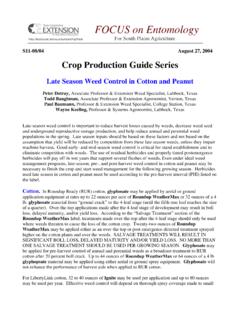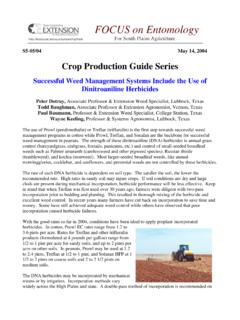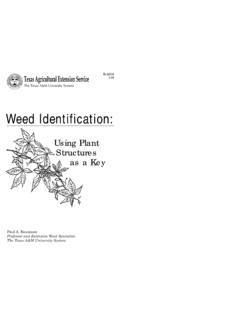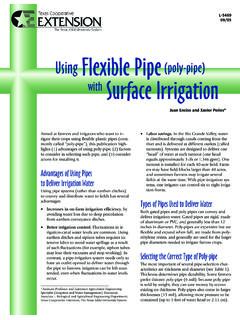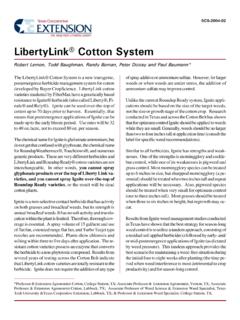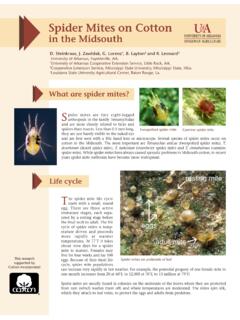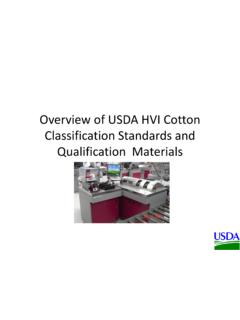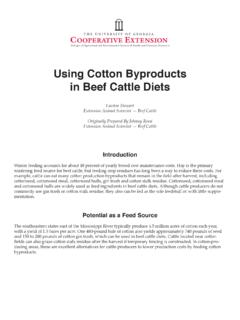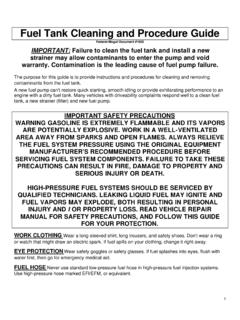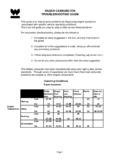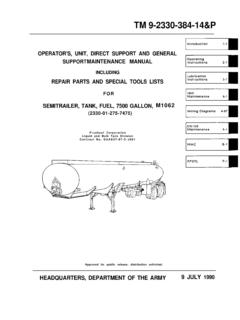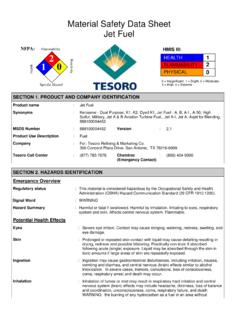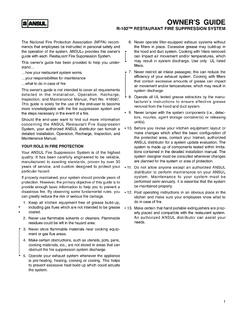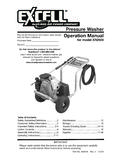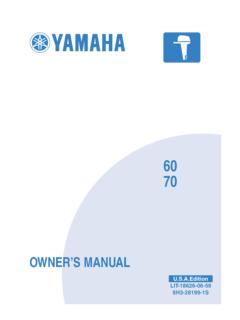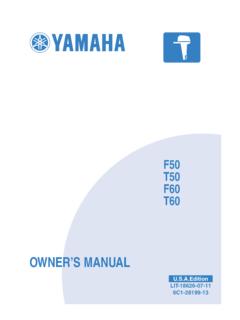Transcription of AGRICULTURAL MU Guide - cotton.tamu.edu
1 Weed Control AGRICULTURAL . MU Guide PUBLISHED BY MU EXTENSION, UNIVERSITY OF MISSOURI-COLUMBIA cleaning Field Sprayers to Avoid Crop Injury Bill Johnson, Department of Agronomy Bill Casady, Department of AGRICULTURAL Engineering Dallas Peterson, Department of Agronomy, Kansas State University Dennis Kuhlman, College of Technology and Aviation, Kansas State University Crop yield and quality depend on effective appli- cation of AGRICULTURAL chemicals. Proper selection, use and maintenance of sprayers can save you money, improve the performance of the agrichemicals you use, and protect the environment. With the increased emphasis on custom applica- tion of herbicides, postemergence weed control, and use of herbicides that are active at low application rates, proper cleaning and maintenance of sprayers will be increasingly necessary to avoid injury to non- target crop species.
2 The issue will take on added importance as more producers use broad-spectrum herbicides such as Roundup and Liberty on their her- bicide-tolerant crops. Postemergence applications sprayed directly on the crop foliage will generally have greater potential for crop injury than will soil applications. Serious crop injury can result from small amounts of herbicides remaining in the sprayer system. In recent years there have been numerous occur- rences of soybean crop damage with symptoms resembling injury from growth regulator herbicides (Figure 1). The injuries were attributed to various causes, including the use of other soybean herbicides and herbicide additives, but in many cases the spray tanks had not been cleaned properly before applying soybean herbicides.
3 Crop injury from sprayer con- tamination can occur up to several months after using Figure 1. Leaf cupping (above) is a sign of sprayer contamina- the sprayer if it has not been cleaned properly. Injury tion injury from growth regulator herbicides. from sprayer contamination can affect crop growth A crop with moderate damage (below) will suffer both delayed maturity and reduced yield. and development for several weeks after application and in severe cases can reduce crop yields. Herbicide residues in the sprayer can be redissolved through General sprayer cleanup procedures later contact with herbicides, their solvents or spray Pesticides can settle to the bottom or cause rapid adjuvants. The objective of this publication is to pre- corrosion in the spraying system and thus should be sent the appropriate cleanup procedures for sprayer washed from the whole system immediately after equipment following the use of various herbicides in use.
4 One should always try to end the workday with corn, soybean, wheat and cotton production. an empty tank. If you will be using the same agri- chemical the next day, thoroughly flushing the $.75 G 4852 Printed with soy ink on recycled paper sprayer tank and sprayer with clean water is suffi- Residues can also accumulate in checked or cracked cient and will help prevent drying and hardening of hoses. Inspect the inside of hoses and replace if neces- pesticide residues. If a different agrichemical will be sary. Pay special attention to the following areas that used, then a more comprehensive procedure is recom- may be missed or difficult to clean: mended immediately after use. sprayer surfaces or components where When cleaning a sprayer, select a location where buildup might occur due to repeated coats of any spilled rinsate will not contaminate water sup- spray followed by drying plies, streams, crops or other plants and where pud- sprayer sumps and pumps dles will not be accessible to children, pets, livestock inside the top of the spray tank and around or wildlife.
5 Preferably the area should be impervious baffles to water and have a wash rack or cement apron with irregular surfaces inside tanks caused by baf- a sump to catch contaminated wash water and pesti- fles, plumbing fixtures, agitation units, etc. cides. If such a facility is not available, catch or con- tain the rinsate and spray the rinse water or the clean- When switching between crops, such as applying ing solution on a field in a manner consistent with the soybean herbicides after corn spraying is complete, intended use of the agrichemical. Avoid discharging follow the procedure described in the box below to all the cleaning solution in a small area. clean out sprayers. The quickest and easiest way to rinse a tank and spraying equipment and dispose of waste safely is to Sprayer cleaning agents carry a 50- to 100-gallon drum of fresh water with the cleaning agents should be selected based on the spraying equipment.
6 When spraying is finished, flush herbicide and formulation to be cleaned (see Table 1). the system in the field and spray the rinsate on the cleaning agents should penetrate and dissolve pesti- field in a manner consistent with the products intend- cide residues and allow them to be removed when the ed use. rinsate is removed from the sprayer. The functions of If spray material is spilled on the sprayer during cleaning agents are dilution, solubilization and deac- loading or mixing, wash the outside of the sprayer tivation. Commercial tank cleaning agents and deter- immediately. As a general rule, plastic or polyethy- gents help remove both water- and oil-soluble herbi- lene tanks and hoses tend to require more extensive cides and are recommended on many pesticide labels.
7 cleaning than stainless steel tanks . Screens and strain- The commercial tank cleaning agents usually perform ers should also be cleaned or replaced frequently as better than household detergents and can deactivate they can be a major source of contamination. some herbicides in addition to solubilizing them. Sprayer cleanout procedure between crops This procedure is recommended for all herbicides 2. Fill the tank with fresh water and add one of the unless the label specifies a different cleanout procedure. cleaning solutions listed below or a commercially 1. Add one-half tank of fresh water and flush tanks , available tank cleaner and agitate the solution for 15. lines, booms and nozzles for at least 5 minutes using minutes.
8 A combination of agitation and spraying. Rinsate Add one of the following to each 50 gallons of sprayed through the booms is best sprayed onto crop- water to make a cleaning solution: land to avoid accumulation of pesticide-contaminated 2 quarts of household ammonia (let stand in rinsate. Thoroughly rinse the inside surfaces of the sprayer overnight for growth regulator herbicides tank, paying particular attention to the surfaces such as 2,4-D, Banvel, Clarity). around the tank fill access, baffles and tank plumbing 4 pounds of trisodium phosphate cleaner deter- fixtures. The use of a 360-degree nozzle, such as the gent. TeeJet Model 27500E-TEF rinsing nozzle, perma- nently installed to the spray system can automate the Operate the spray booms long enough to ensure thorough cleaning of tops and sides of the tanks .
9 That all nozzles and boom lines are filled with the Several nozzles may need to be carefully positioned cleaning solution. Let the solution stand in the system to clean tanks with baffles. Pressure sprayers are for several hours, preferably overnight. Agitate and useful for removing caked on internal and external spray the solution onto an area suitable for the rinsate residues. Hot water can increase penetration of dried solution. residues, but the addition of hot water rinsing may 3. Add more water and rinse the system again by using cause unacceptable health hazards due to the vapors a combination of agitation and spraying. Remove noz- produced. Carefully review labeled safety precautions zles, screens, and strainers and clean separately in a for the agrichemicals and cleaning products used.
10 Bucket of cleaning agent and water. See also MU publication G1917, Personal Protective 4. Rinse and flush the system once again with clean Equipment for Working With Pesticides. water. Page 2 G 4852. 3. Flush the solution out of the spray tank through Some tank cleaning agents and ammonia solu- the boom. tions also raise the pH of the rinsate solution, making 4. Remove the nozzles and screens and flush the some products such as sulfonylurea herbicides more system with two full tanks of water. water soluble and thus easier to remove from internal The steps listed below are suggested for thorough sprayer parts. Chlorine bleach solutions will acceler- cleaning of spray equipment used to apply Resolve SG. ate decomposition of sulfonylurea and some other herbicide as a tank mix with wettable powders, emulsifi- herbicides into inactive compounds.
